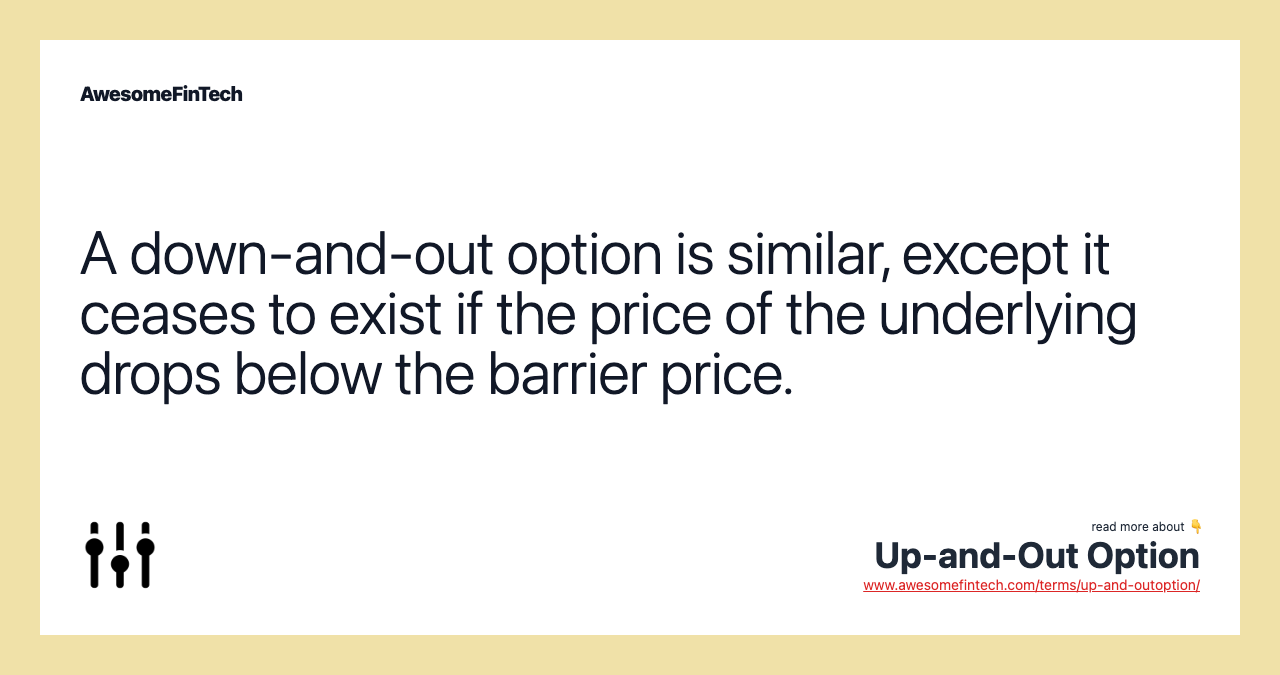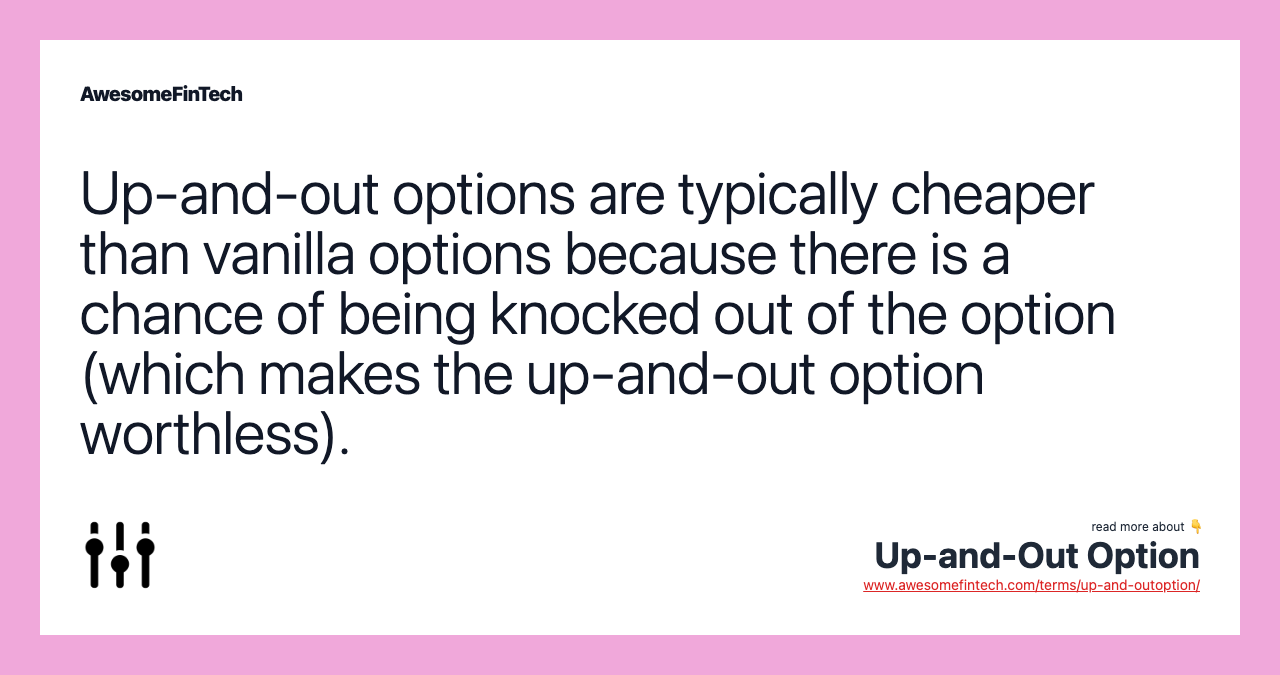Up-and-Out Option
An up-and-out option is a type of knock-out barrier option that ceases to exist when the price of the underlying security rises above a specific price level, called the barrier price. If the price of the underlying does not rise above the barrier level, the option acts like any other option — it gives the holder the right but not the obligation to exercise their call or put option at the strike price on or before the expiration date specified in the contract. An up-and-out option is a type of options contract that ceases to exist if the underlying moves above a certain price point, called the barrier. A down-and-out option is similar, except it ceases to exist if the price of the underlying drops below the barrier price. Up-and-out options are typically cheaper than vanilla options because there is a chance of being knocked out of the option (which makes the up-and-out option worthless). Considered an exotic option, an up-and-out option is one of two types of knock-out barrier options. An up-and-out option is a type of knock-out barrier option that ceases to exist when the price of the underlying security rises above a specific price level, called the barrier price. If the price of the underlying does not rise above the barrier level, the option acts like any other option — it gives the holder the right but not the obligation to exercise their call or put option at the strike price on or before the expiration date specified in the contract. An up-and-out option is a type of options contract that ceases to exist if the underlying moves above a certain price point, called the barrier. A down-and-out option is similar, except it ceases to exist if the price of the underlying drops below the barrier price. Up-and-out options are typically cheaper than vanilla options because there is a chance of being knocked out of the option (which makes the up-and-out option worthless). Considered an exotic option, an up-and-out option is one of two types of knock-out barrier options. A barrier option is a type of option where the payoff, and the very existence of the option, depends on whether or not the underlying asset reaches a predetermined price. The critical concept for a knock-out option is that if the underlying asset reaches the barrier at _any_ time during the option's life, the option is knocked out and will not come back into existence. At the option's inception, the price of the stock was $75, but before the option was exercisable, the price of the stock reached $100.

What Is an Up-and-Out Option?
An up-and-out option is a type of knock-out barrier option that ceases to exist when the price of the underlying security rises above a specific price level, called the barrier price.
If the price of the underlying does not rise above the barrier level, the option acts like any other option — it gives the holder the right but not the obligation to exercise their call or put option at the strike price on or before the expiration date specified in the contract.



Understanding Up-and-Out Options
Considered an exotic option, an up-and-out option is one of two types of knock-out barrier options. (The other type of knock-out barrier option is a down-and-out option.) Both kinds come in put and call varieties. A barrier option is a type of option where the payoff, and the very existence of the option, depends on whether or not the underlying asset reaches a predetermined price.
A knock-out will expire worthless if the underlying reaches a certain price, limiting profits for the holder and limiting losses for the writer. The critical concept for a knock-out option is that if the underlying asset reaches the barrier at any time during the option's life, the option is knocked out and will not come back into existence. It does not matter if the underlying moves back below pre-knock-out levels.
For example, an up-and-out option has a strike price of $80 and a knock-out price of $100. At the option's inception, the price of the stock was $75, but before the option was exercisable, the price of the stock reached $100. This valuation means the option automatically expires worthless because it hit or exceeded the barrier level — it does not matter where the underlying trades before the exercise date.
A barrier option can alternatively be constructed as a knock-in. In contrast to knock-outs, a knock-in option has no value until the underlying reaches a certain price.
Up-and-outs can also be compared with down-and-out options. With a down-and-out option, if the underlying falls below the barrier price, the option ceases to exist.
An up-and-out option can be a call or put. Both get knocked out if the underlying rises above the barrier price.
Using Up-and-Out Options
Large institutions or market markers create these options via direct agreements with clients seeking them. For example, a portfolio manager can use them as a less expensive method to hedge against losses on a short position. The hedge would be less costly than buying vanilla call options. However, it would be an imperfect hedge because the buyer would be unprotected if the security price increased above the barrier price.
Pricing still depends on all the regular options metrics — the knock-out feature adding an extra dimension. Since options trade over the counter, there is typically limited liquidity for such instruments. This means the buyer will need to accept the premium (cost) offered to them (or else attempt to negotiate a better price with the seller). Vanilla option premiums can provide a baseline estimate to work off of. Typically, an up-and-out call option should have a lower premium than a vanilla call option with the same expiration and strike.
Example of an Up-and-Out Option
As an example, assume that an institutional investor is interested in buying calls on Apple Inc. (AAPL) because they believe the price will rise. They need to buy 100 contracts, so they want to keep the cost as low as possible. They consider buying an up-and-out option since they tend to be cheaper than similar vanilla calls.
Say that Apple stock is trading at $200. The investor believes the price will rise above $200 over the next three months but probably won't rise above $240. They decide to buy an at-the-money up-and-out option with a strike price of $200, an expiration in three months, and a knock-out level of $240.
A vanilla option expiring in three months with a $200 strike is trading for $11.80 (or $1,180 per contract, which includes 100 shares). The investor needs to buy 100 contracts, for a total cost of $118,000.
They have received a quote that an investment bank will offer them the up-and-out for $8.80, for a total cost of $88,000 ($8.80 x 100 shares x 100 contracts). This saves the firm $30,000 on premium costs.
The investor's breakeven is $200 plus the cost of the option ($8.80), or $208.80. Apple stock needs to move above $208.80 within the next three months in order for the investor to cover the cost of the options. They make money if the price of Apple trades above $208.80 but also remains below $240.
If, at any time before expiration, the price of Apple stock touches $240, the options cease to exist and the investor loses the premium they paid ($88,000).
Related terms:
At The Money (ATM)
At the money (ATM) is a situation where an option's strike price is identical to the price of the underlying security. read more
Barrier Option
A barrier option is a type of option where the payoff depends on whether the underlying asset reaches or exceeds a predetermined price or barrier. read more
Breakeven Point (BEP)
In accounting and business, the breakeven point (BEP) is the production level at which total revenues equal total expenses. read more
Call Option
A call option is a contract that gives the option buyer the right to buy an underlying asset at a specified price within a specific time period. read more
Down-and-In Option
A down-and-in option is a type of knock-in barrier option that becomes active when the price of the underlying security falls to a specific price level. read more
Down-and-Out Option
A down-and-out option is a type of knock-out barrier option that expires when the price of the underlying security falls to a specific price level. read more
Double Barrier Option
A double barrier option is a class of option that either comes into existence or ceases to exist if the underlying reaches a high or a low trigger level. read more
Exercise
Exercise means to put into effect the right to buy or sell the underlying financial instrument specified in an options contract. read more
Exotic Option
Exotic options are options contracts that differ from traditional options in their payment structures, expiration dates, and strike prices. read more